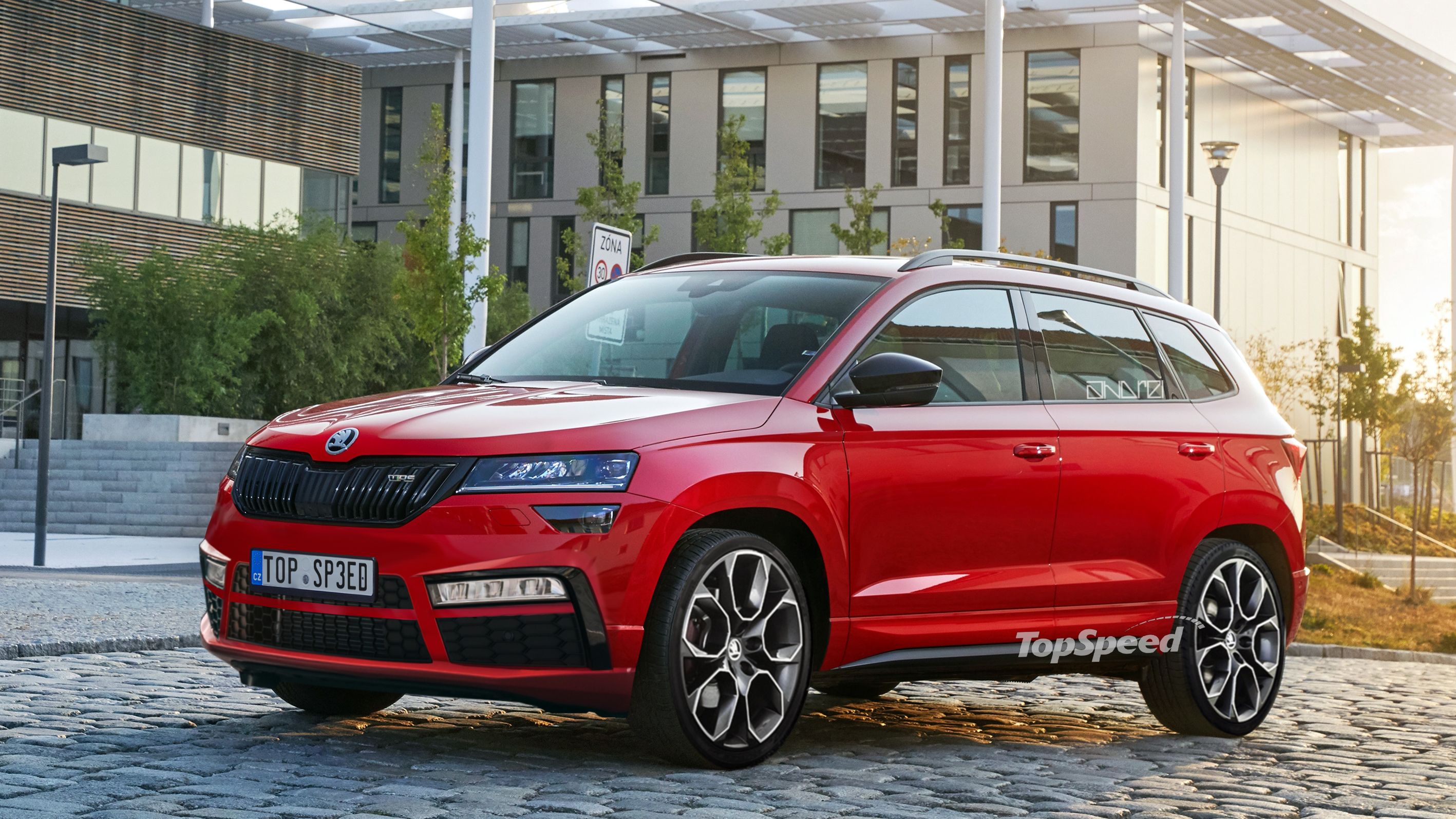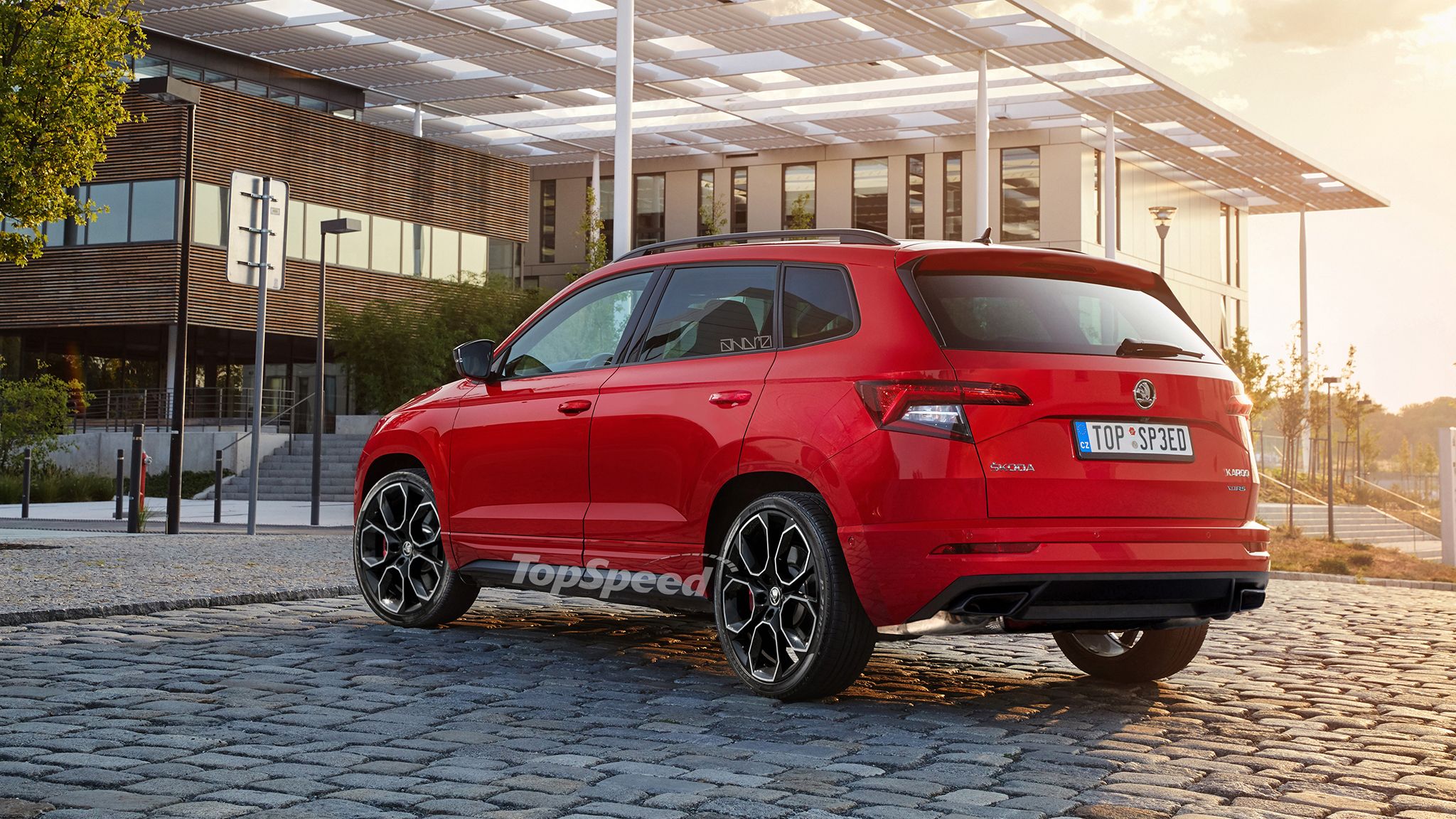Introduced in 2017 to replace the Yeti, the Karoq is Skoda's first authentic foray into the compact crossover market. Already available in variety of trims, including the rugged Scout and the sportier Sportline, the Karoq is about to enter the performance market with an RS badge.
Set to break cover in 2019, the Karoq RS will most likely share underpinnings with the hot Cupra Ateca, built by Seat's recently founded performance division. This means that unlike the Kodiaq RS, which features a diesel engine, the Karoq RS will deliver solid performance. Expect it to boast a more aggressive exterior and unique features inside the cabin. Until the actual SUV breaks cover, we created a rendering that previews its exterior design.
2020 Skoda Karoq RS
- Make: Array
- Model: 2020 Skoda Karoq RS
- [do not use] Vehicle Model: Array
Exterior
Just like the larger Kodiaq RS, the Karoq RS won't be notably more aggressive than the standard model.
On top of that, Skoda will probably design a new bumper to set the RS apart. My bet is on a new vent configuration, probably a three-piece layout with notably bigger openings on each side and in the center. Also look for a honeycomb mesh. We went with additional lights in the bumper and black trim at the corners for a more premium look. Of course, the grille will be finished in black like on all Skoda RS models and it should also have a special badge.
Onto the sides, I think the RS will look a lot like the Sportline model. It will have the same black window frames and mirror caps, and the tiny badges on the front fenders. Of course, the badge will have an RS logo. The SUV will feature new, unique wheels as well. We used a modern design with intricate spokes in our rendering, but it remains to be seen if Skoda will offer something similar or a much simpler design.
Changes will be even less noticeable around back. Again, expect it to look just like the Sportline model for the most part, with a couple of revisions. First, it should get a slightly bigger roof spoiler. Second, an "RS" badge will find its way on the tailgate.
All told, it won't be as exciting as other performance SUVs, but it will stand out in the lineup.
Interior
Don't get your hopes up for a significantly sportier cabin. Just like the Kodiaq RS, the Karoq RS will feature only a handful of upgrades.
You and the front passenger will sit in sportier seats with heavier side bolstering. Not that the Karoq RS will be designed for track duty, but it will be a bit more comfortable during high-speed turns and long trips. The seats will have an exclusive design with Alcantara upholstery and diamond-cross stitching in red.
We should see matching stitching on the door armrests, upper door panels, and on the steering wheel. The latter will have a flat bottom and a "vRS" badge on the lower spoke, just like the Kodiaq RS. The instrument cluster will remain unchanged for the most part, but the Sport mode will unlock revised graphics and a speedometer with red accents.
Perhaps Skoda will make use of carbon-fiber-like plastic in the Karoq RS as well. Already used in the Kodiaq RS, it doesn't look very authentic, but it's definitely a better option to the hard plastic found in most Skoda vehicles. Should the Czech automaker use it, expect to find it on the passenger-side dashboard and on the door panels.
Finally, the Karoq RS should feature stainless steel pedal covers and blacked-out chrome trim on the A/C vents for a sportier look.
These modifications won't alter the Karoq's hauling capacity, so it will still be able to carry 479 liters (16.9 cubic feet) of luggage behind the second-row seats or 589 liters (20.8 cubic feet) when these are tilted. Fold the seatbacks down and move them forward and storage room jumps to no fewer than 1,605 liters (56.7 cubic feet). You can also remove the rear seats completely for a total capacity of 1,810 liters (63.9 cubic feet).
Drivetrain
Powered by a diesel engine rated at 237 horsepower and 369 pound-feet of torque, the Kodiaq RS is rather disappointing performance-wise. But word has it Skoda won't make the same mistake with the Karoq and plans to drop a significantly more powerful engine under the hood. And this time around it will be a gasoline mill.
But what's Skoda planning to use, because the standard Karoq comes with very small and not very powerful gas engines. The range-topping 1.5-liter four-cylinder generates 148 horsepower and that's not enough for an RS-badged vehicle. Word has it Skoda plans to take the larger, 2.0-liter four-cylinder from sister brand Seat. The turbocharged four-banger cranks out a solid 296 horsepower and 280 pound-feet of torque in the Cupra Ateca and the same rating should carry over to the Karoq RS.
Similarities to the Cupra model will probably continue in the transmission and drive departments, so expect it to arrive with a seven-speed DSG gearbox and an all-wheel-drive system. The Ateca needs 5.4 seconds to hit 62 mph from a standing start and I don't see why the Karoq RS won't be equally quick. Unless it's not as powerful, of course. Top speed should also remain identical to 152 mph.
An adaptive suspension system will be standard. It will make the Karoq sit almost an inch lower than the standard crossover, but it will also feature firmer spring rates. The 17-inch brakes will be bigger than the regular ones, but Skoda could offer a Brembo update. This is an option on the Cupra Ateca and the Czech firm could offer the same upgrade for extra stopping power.
Pricing
The Skoda Karoq comes in at an affordable €22,490 (around $25,550 as of January 2019) in base trim, but the RS will cost more than that. Actually, it will fetch more than the Sportline version, which retails from €30,520 (about $34,660), and become the most expensive model of the range. Look for a sticker just below the €40,000 (around $45,450) mark.
The Karoq RS will break cover sometime in 2019, but it won't come to North America.
Competition
Cupra Ateca
Sharing underpinnings saves companies a lot of money, but it also means that the vehicles go against each other on the market in most cases. The same will happen with the Karoq RS and the Cupra Ateca, as these vehicle will share underpinnings, technology, and will probably have the same output. It will mostly be a matter of taste as the Ateca looks different inside and out. Cupra models sit a bit higher on the premium ladder, but not by much, so it will also come down to what brand you're attached the most. Because it's supposed to have the nicer interior a better materials, the Cupra Ateca is a bit more expensive than what the Karoq RS is expected to fetch. Pricing starts from €42,850 (around $48,690), at least €3,000 more than the Czech SUV.
Read our full review of the 2019 Cupra Ateca.
BMW X3
BMW has yet to launch a full-fledged version of the M, but it doesn't really need one against the Karoq RS. The xDrive30i model is well suited here, even though the 2.0-liter four-cylinder engine is less powerful at 249 horsepower and 258 pound-feet of torque. However, the X3 has superior dynamics and is just as fast. But you can opt for a 300+ horsepower crossover if you want more oomph. The M40i variant draws juice from a 3.0-liter six-cylinder engine that generates 355 horsepower and 369 pound-feet of torque. The bad news is that the X3 competes in a more upscale market, so it will blow a bigger hole in your bank account. The xDrive30i starts from €52,600, while the M40i comes in at a whopping €68,700 before options. The X3 is the only vehicle in this comparison that's available in the United States.
Read our full story on the 2018 BMW X3.
Conclusion
The fact that Skoda wants to expand its RS offerings to the SUV market is great news, but it remains to be seen if the Karoq will become a proper RS or just a milder vehicle, like the Kodiaq. Fortunately, Skoda already offers a mild Sportline model, so there's a big chance that the Karoq RS will share underpinnings with the cool Cupra Ateca. Sure, it might not be as dynamic as the BMW X3, but it will also be notably more affordable, yet it will be as powerful as a hot-hatch. Definitely anxious to see this crossover in showrooms.
Further reading
Read our full review on the 2018 Skoda Karoq.
Read our full review on the 2019 Skoda Kodiaq RS.




